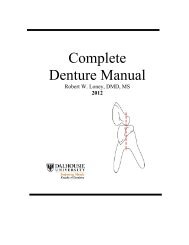RPD Manual 11 - Removable Prosthodontics - Dalhousie University
RPD Manual 11 - Removable Prosthodontics - Dalhousie University
RPD Manual 11 - Removable Prosthodontics - Dalhousie University
You also want an ePaper? Increase the reach of your titles
YUMPU automatically turns print PDFs into web optimized ePapers that Google loves.
Framework Adjustment - 85<br />
2. Reciprocal arms and proximal plates should be contacting the cast<br />
3. Linguoplates and maxillary palatal major connectors should be in intimate contact<br />
with the cast (food impaction)<br />
4. Major and minor connectors should be an adequate distance from abutment<br />
teeth (hygiene). Adjust, if possible, or have lab adjust or remake framework<br />
5. Major and minor connectors should be of proper proportions (rigidity, hygiene).<br />
Note especially that cingulum rests should not be carried into embrasures and that<br />
embrasure minor connectors for distal extensions should not be in contact with the<br />
more anterior tooth (unless it has a rest seat preparation). Adjust, if possible, or<br />
have lab adjust or remake framework.<br />
6. Butt joints should be adequate for acrylic resin (slightly undercut). Adjust, if<br />
possible, or have lab adjust or remake framework<br />
7. Clasps should be of uniform taper<br />
8. Proper gridwork should have adequate relief<br />
9. Finish and polish of the framework should be adequate - no evidence of pits,<br />
nodules and scratches in the metal. Eliminate sharp edges that might impinge on<br />
the oral mucosa.<br />
Check framework with an instructor prior to making adjustments. These adjustments should<br />
proceed the patient's clinical appointment for framework adjustment. Heatless stones, diamond<br />
burs, Brasseler E-Cutter burs, carborundum disks and coarse stones may be used to make<br />
adjustments to the major and minor connectors. Remove and replace the framework on the<br />
master casts as few times as possible. In this way, it will not be severely abraded should a<br />
remake of the framework be necessary.<br />
Clinical Adjustment (Fit)<br />
Binding against one or more of the abutment teeth can cause inadequate seating of a<br />
framework. The area(s) of binding cannot be located without the use of an indicating<br />
medium. Several media can be used for this purpose:<br />
1. Spray type Powders (Occlude): A small amount is sprayed in an even<br />
continuous layer over ALL tooth-contacting portions of the framework. The<br />
advantage of this medium is that it is thin and accurate and is not easily displaced<br />
from the framework. The material can get quite thick if over-sprayed. Teeth,<br />
tissues and the framework must be dry to prevent the pigment bleeding and<br />
making reading of the indicator difficult. A disadvantage of this technique is that<br />
it provides only two-dimensional assessment of fit.<br />
2. Disclosing wax (Kerr): A small amount of wax is removed from the jar and<br />
placed on a mixing pad. A warmed instrument (#7 wax spatula, PKT waxing<br />
instrument, etc.) is used to pick up and melt a portion of the wax. The melted<br />
wax is applied in an even coat over ALL tooth-contacting portions of the<br />
framework. The wax is allowed to gel prior to placement in the mouth. The<br />
advantage of this medium is that it provides three-dimensional assessment of fit.<br />
Areas of burn-through indicate possible areas of binding, and the thickness of the<br />
remaining wax indicates how far the rest of the framework is from contact with<br />
the teeth. A disadvantage of wax is that it can stick to teeth or be wiped away<br />
easily if the framework is seated improperly.















